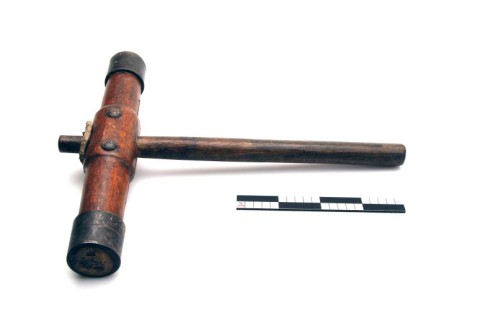Research
Search our website
Search our website by entering a keyword or choose a database above to search specifically.
Search
Showing search results 3,381 - 3,390
14,752 results found

Chain hook
The chain hook is an approx. 80 cm long iron hook with a T or ring handle,
with which heavy (anchor) chains can be transported on ships or in the
harbor, for example during a check. When the vessel is stopped by a chain
when launching a boat, the worker at the capstan catches that chain with
the aid of two shorter chain hooks (1). [MOT] (1) FROST: 140.

Chaff cutter knife
This text can only be consulted in Dutch
<https://www.mot.be/resource/Tool/chaff-cutter-knife?lang=nl>

Chain pipe wrench
This text can only be consulted in Dutch
<https://www.mot.be/resource/Tool/chain-pipe-wrench?lang=nl>

Caulking mallet
This text can only be consulted in Dutch
<https://www.mot.be/resource/Tool/caulking-mallet?lang=nl>

Chaquitaclla
The chaquitaclla (1) (pronounced tcha-ki-tak-li-ja) is a typical
agricultural implement in the Andes mountains of southern Peru and northern
Bolivia. The men use them to work fallow soil by tilting the clods - as
with the Spanish Laya, after which the women pow the potato tubers by hand
(2). It is not uncommon for five men to work side by side; then they tilt a
whole bar in one go. The chaquitaclla evolved from a digging stick to a
tool with a sharp metal tip, a curved or straight handle, and a footrest.
It is about 1 to 1.5 meters long and has a diameter of about 6 cm. The
footrest consists of two poles of approx. 20 cm long that are tied parallel
to each other at a height of approx. 45 cm. The wooden handle is tied to
the shaft with strips of llama or cow leather. When working on steep
slopes, a lower-placed handle - close to the footrest - is more convenient
for balancing. The stem fits into the socket of the blade, which is about
7-10 cm wide and 40 cm long. If no metal is available...

Chalk line
This text can only be consulted in Dutch
<https://www.mot.be/resource/Tool/chalk-line?lang=nl>

Chamfering shave
This text can only be consulted in Dutch
<https://www.mot.be/resource/Tool/chamfering-shave?lang=nl>

Charcoal iron
This text can only be consulted in Dutch
<https://www.mot.be/resource/Tool/charcoal-iron?lang=nl>

Chasing hammer
This text can only be consulted in Dutch
<https://www.mot.be/resource/Tool/chasing-hammer?lang=nl>

Cheese knife
This text can only be consulted in DutchSee also the cheese cutting knife
and the cheese cutter.








